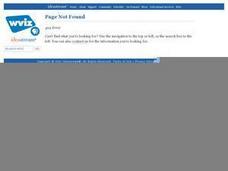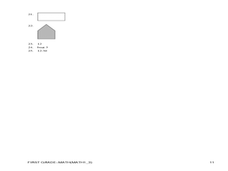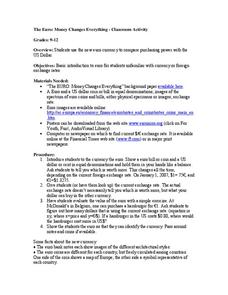Curated OER
All About Money
Few topics engage young mathematicians as much as learning about money. Through a series of shared readings and hands-on activities, children explore the US currency system, learning how to count money and calculate change as they create...
Attainment Company
Money Skills
Young mathematicians learn to make sense out of money with this collection of skills practice worksheets. From identifying the different coins and bills in the US currency system, to counting money and correctly using the dollar and...
Curated OER
"In God We Trust": The Camden Man Who Put the Missing Motto on the Dollar Bill
Here is a fascintating lesson which relates how the motto "In God We Trust" came to appear on all US currency. It turns out that a man from Arkansas came up with the idea and petioned his congressman and President Eisenhower himself to...
Curated OER
Money Counts
Fourth graders identify bills and coins to $20 bills and make equivalencies. They organize bills and coins in groups from greatest to least and least to greatest. Students count out change.
Curated OER
Lesson: More Than a Dollar's Worth of Meaning
The Chinese, Dish with the Eight Buddhist Emblems contains symbols and visual references for learners to explore. They search for Buddhist symbolism on the dish and then they use their observation skills to locate and explore the meaning...
Curated OER
Dollars and Cents Word Problems
Explore money math with these addition and subtraction word problems. Learners solve three scenarios, each of which is illustrated for visual learners. They use knowledge of different types of US currency to determine how much money is...
Curated OER
Working with Coins #2
Practice money math with a helpful worksheet. Illustrations of coins, along with word problems, keep second graders focused on adding and subtracting different amounts of money. An excellent homework assignment to reinforce your money...
Curated OER
Working with Money
How much money do you have? Scholars add up dollars and cents to get totals for 12 visual addition problems. They look at pictures of the currency and write the total numerically (remember that dollar sign). Although the coin images look...
Curated OER
The Role of Money
Fourth graders examine the role of money. In this money lesson, 4th graders read a chapter from Judy Blume's, Double Fudge, to see how money is made and how people make money. They finish a worksheet, and play a game about money.
K12 Reader
Money, Money, Everywhere!
Pennies, nickels, dimes, quarters, half-dollars, dollars. Here's a comprehension worksheet that asks young readers to respond to a series of questions based on a passage about money.
Curated OER
Give Me the Money
Students view a money transaction on video and identify the steps involved in making a purchase and calculating change. They write out original money math problems and exchange them with classmates.
Curated OER
What's All this Money Madness?
Second graders examine the value of money. In this money instructional activity, 2nd graders read the book Money Madness by David A. Alder and watch Brain Pop Jr. videos. Students discuss why we need money and how people earn money....
Curated OER
First Grade Math: 1-3
For this first grade math review worksheet, 1st graders answer multiple choice questions about symmetry, money, measurement, time, and more. Students complete 25 questions.
Judicial Learning Center
The Constitution
Supreme Court justices debate the meaning of the US Constitution, but we expect teachers to explain it to scholars with far less training and experience. A daunting task for sure, but it's not insurmountable with resources that simplify...
CK-12 Foundation
Mode: Mucho Money
Generate stacks of money. Given bills of different denominations, pupils stack them based on their values. The learners figure out which value is the mode of the data and determine whether the data is unimodal, bimodal, or multimodal.
Curated OER
Money Vocabulary
In this money learning exercise, students match money vocabulary with their meanings and money amounts. Students complete 20 matches total.
Curated OER
Using Money
In this money worksheet, 4th graders study how coupons allow people to buy things for less than full price. Students use the information acquired to answer 3 short answer math problems.
Curated OER
Breaking News English: Zimbabwe's New Currency
In this Zimbabwe's new currency worksheet, learners read the article, answer true and false questions, complete synonym matching, complete phrase matching, complete a gap fill, answer short answer questions, answer discussion questions,...
Curated OER
The Euro: Money Changes Everything
Ninth graders compare the Euro with the purchasing power of the US dollar. In this economic lesson plan, 9th graders evaluate the value of the Euro through various exercises. Students research the currency exchange rates of the Euro.
Curated OER
Regents Review Worksheet #1: Principles of the U.S. Constitution
Kids who take the Regents Exam really need to know a lot of information. This is a wonderful exam review tool that includes 26 pages of questions, charts, and suggested readings to help upper graders pass the test. It focuses on all...
Curated OER
Money
In this math activity, students examine drawings of the 1,5, 10 and 20 dollar U.S. paper bills. There are no instructions on the page about what students are to do with these.
Curated OER
Scuba, Dooba, Do
In this money worksheet, 3rd graders read a math scenario about 6 people going on a snorkeling trip. Students add together how much each person has to spend and what two items each person buys. Students choose 3 items they would like to...
Texas Commission on the Arts
The Quarter Fold
Little ones identify the US quarter and explore the concept of one-fourth or one-quarter. Using real coins or coin manipulatives, they divide a square piece of paper into quarters, discuss halves and quarters, and create a design that...
Curated OER
3rd Grade Math
In this math review learning exercise, 3rd graders complete multiple choice questions about shapes, money, weight, and more. Students complete 20 questions.

























